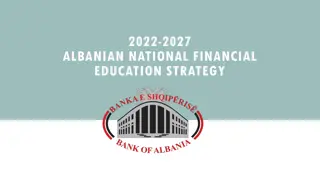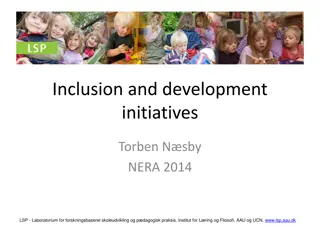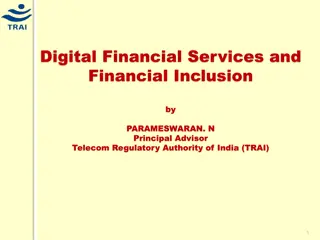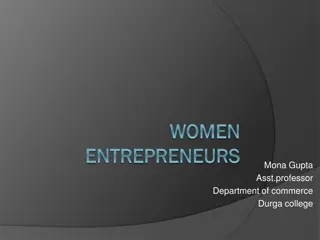Enhancing Financial Inclusion for Women and the Poor: Insights and Challenges
Discover how financial inclusion can empower women and alleviate poverty through access to formal financial services. Explore key findings on global inclusion status, the impact of digital payments, and open questions regarding macro-relevance and policy implications. Delve into crucial aspects like account ownership benefits versus credit accessibility and how inclusion influences government policies.
Download Presentation

Please find below an Image/Link to download the presentation.
The content on the website is provided AS IS for your information and personal use only. It may not be sold, licensed, or shared on other websites without obtaining consent from the author.If you encounter any issues during the download, it is possible that the publisher has removed the file from their server.
You are allowed to download the files provided on this website for personal or commercial use, subject to the condition that they are used lawfully. All files are the property of their respective owners.
The content on the website is provided AS IS for your information and personal use only. It may not be sold, licensed, or shared on other websites without obtaining consent from the author.
E N D
Presentation Transcript
How can financial inclusion help women and the poor? Leora Klapper Discussion: Sole Martinez Peria Macro Financial Division Research Department IMF Prepared for the World Bank Conference Finance and Development: The Unfinished Agenda November 2, 2016 World Bank Group Headquarters
What do we learn? Latest numbers on inclusion oAround the world oBy gender oBy income strata Some low hanging fruits to increase inclusion oE.g., payment of government wages and transfers into accounts Nice summary of the empirical evidence on the impact of inclusion and, in particular, of digital payments Reminder that there is a lot we do not know yet
Open questions Is financial inclusion macro-relevant? 1. 2. Which aspect of inclusion matters most? Does financial inclusion impact the effectiveness of government policies? 3. 4. Is there a dark side to financial inclusion? What are the barriers to inclusion? 5. 6. What policies promote financial inclusion? What are the preconditions for "safe" inclusion? 7.
Is financial inclusion macro-relevant? Most of the existing evidence is at the micro-level. o There are concerns about external validity and non-measured general equilibrium effects. o Sahay et al (2015) is an exception but data is limited and identification is questionable. More research is needed: To measure the impact of inclusion on growth and income inequality at the macro level. 1. To identify the mechanisms by which financial inclusion can have macro economic effects and affect growth and income inequality. 2. Data and proper identification are significant limitations here.
Which aspects of financial inclusion matter most? Episodes such as the US sub-prime crisis and the microfinance crisis in India have raised concerns about the wisdom of promoting access to credit by the poor. Hence, financial inclusion efforts have tilted significantly towards promoting account ownership. Is this the right focus? Can we be sure that promoting account ownership yields better long-run outcomes regarding growth and income inequality relative to access to credit or to insurance?
Does inclusion affect other government policies? Is the effectiveness of monetary policy affected by the extent of financial inclusion? How does inclusion affect fiscal policy? oDoes it reduce tax evasion? oCan fiscal multipliers be influenced by financial inclusion?
Is there a dark side to financial inclusion? Which aspects of financial inclusion can have a negative impact on financial stability and under what circumstances? oCredit to low income individuals? oGrowth of accounts without appropriate safeguards against money laundering? oFast pace growth of accounts with poorly regulated institutions that cannot safely intermediate funds?
What are the main barriers to inclusion? Some demand side evidence exists on the importance of eligibility, distance, and trust. Need better supply side data on: oDocumentation and other eligibility requirements oFees and other costs oAvailable forms of delivery of services
What policies best promote financial inclusion? Limited evidence available. oAllen et al. (2016) Many countries are pursuing financial inclusion strategies. What do we know about the effectiveness of the policies being implemented? Is there a preferred set of measures? Is there a recommended sequencing?
What are the preconditions for "safe" inclusion? How important is the regulatory environment? What regulations make sense and which ones don t? How important is consumer protection? Who is best positioned to do this? How critical is financial literacy? What concepts should be emphasized and through which delivery channels?
In sum WB efforts and in particular Leora swork on inclusion has been vital in advancing our understanding of the subject. Findex data have been key to mapping financial inclusion around the world. Yet, there are still many open questions and room for further research.























